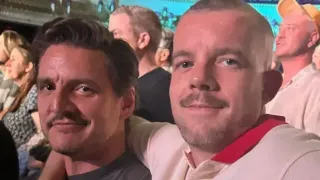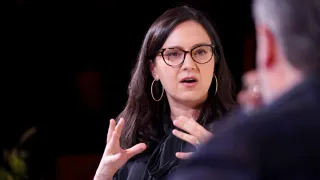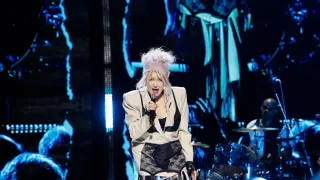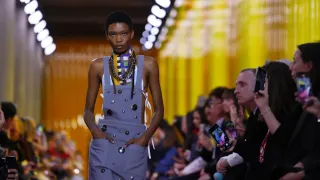August 30, 2014
Ira Sachs on 'Love is Strange'
Kilian Melloy READ TIME: 4 MIN.
It's a personal prejudice of mine that I believe well-made fiction films are often far more accurate and truthful portraits of our messy human tribes than even the most scrupulously produced documentaries. A case in point is the latest brilliant fiction from the Memphis-raised/New York City-residing filmmaker Ira Sachs.
In "Love is Strange," Sachs begins with the nuptials of two 60-something New Yorkers. A painter, Ben (John Lithgow), and a music teacher, George (Alfred Molina), decide to use the passage of New York's Marriage Equality Act to legally baptize their nearly 40-year union. The film opens with a love fest as friends and family of the couple celebrate a long-overdue public recognition of their life together.
Soon, real life intrudes. George is fired from his job at a Catholic high school, and the couple find themselves technically "homeless," unable to make the mortgage payments on their co-op apartment. Since none of their friends have space in their own cramped quarters for a couple, Ben moves in with Kate (Marisa Tomei), a novelist; her husband, Elliot (Darren Burrows); and their teenage son, Joey (Charlie Tahan); while George bunks down on the couch of two gay cops (Cheyenne Jackson and Manny Perez).
Suddenly, all bets are off. Ben is particularly hard-hit, as his mere presence in the flat puts a crimp in Kate's daily writing ritual. At the same time, Ben's being in the lower bunk of Joey's bed causes the teen to start resenting his once-beloved gay "uncle," while also putting the kid's own burgeoning romantic life on hold.
My phone chat with Ira Sachs, who co-wrote "Love is Strange" with Mauricio Zacharias (also his writing partner on their previous feature, "Keep the Lights On" ), explored his philosophy and methods as American queer film's most adroit chronicler of relationships, whether fleeting ("The Delta"), severely challenged ("Forty Shades of Blue"), fatally flawed ("Married Life"), or full of bumps and bruises ("Keep the Lights On", a film he concedes was significantly autobiographical). I began by noting that the film was his second outing with screenwriting partner Zacharias.
Ira Sachs: It helps that we're both family -- he's the godfather of my two-year-old son -- and we share a lot of values, similar curiosities about life and relationships and family intimacy, and that's a very good place to start an artistic collaboration.
David Lamble: Your setup is sublime: a happily-together gay couple for whom marriage should represent the apex of happiness, but for whom George's firing from his Catholic school job starts a cascade of problems.
The film is an examination of love at different stages in life, and from different perspectives, so you have this older couple (John and Alfred); you have Marisa Tomei and Darren Burrows, who are very much a couple in the middle of their life; and you have this adolescent played by Charlie Tahan, who is an extraordinary young actor, who's really learning about love for the first time.
We wanted to create a multi-generational family epic, but to stage it in a very cramped New York apartment. For that you need drama, and the issue around marriage equality and the firing that happens at the beginning of the film is really the engine that sets off this examination of love and family and relationships.
You take a direct hit at the Catholic Church. Alfred Molina's character is fired by the Church for actually getting married to his life partner.
When we started working on the film, I read about a case that happened in the Midwest about a man who married his partner, and then was fired as a Catholic high school choir director. So in a way, my job as a filmmaker is to be a historian. I'm speaking to things that are of our time. My job is not to judge, but to explore. I tried to be very empathetic to everybody, including the priest who has to fire his employee.
Describe the relationship between teenager Joey and the couple, especially with John Lithgow's Ben, who's actually taking over Joey's room.
It's a film that's about education with a small "e." There is this sense of what we learn from each other as family, and one of the things that was so special is the cast I got to work with, who brought a level of humor and comedy that makes them even more life-like. I started writing the film in January 2012, and in that month I went from living alone in my New York apartment to living with my husband, our two kids, their mom, and visiting family members, so I had right in front of me drama and all the comedy that I could hope for.
Growing up, you could probably imagine yourself living the life of an artist, but in your wildest imagination could you have imagined the rest of your current life?
I think your question points to what is so poignant about Ben and George as a couple: Here are two gay men in a relationship who have also lived through the AIDS epidemic and the sort of changing relationship of their culture to their love. The film begins with a wedding; it contains also the struggle that these two went through personally and as part of history to get to that moment. It's very poignant that this is also the catalyst of their separation. This is a film that tries to honor the struggles of their generation.
When I first met my husband Boris Torres, who does the paintings for John Lithgow, he was living in an apartment in the West Village. On the middle floor of this townhouse was a 77-year-old, very eccentric gay man, and on the top floor were two policemen who were a couple. And we lived there, often watching TV together and having meals together, and there was this kind of communal story that I was very moved by. That's what a lot of people who move to cities like New York build for themselves. It's how we get through life.






